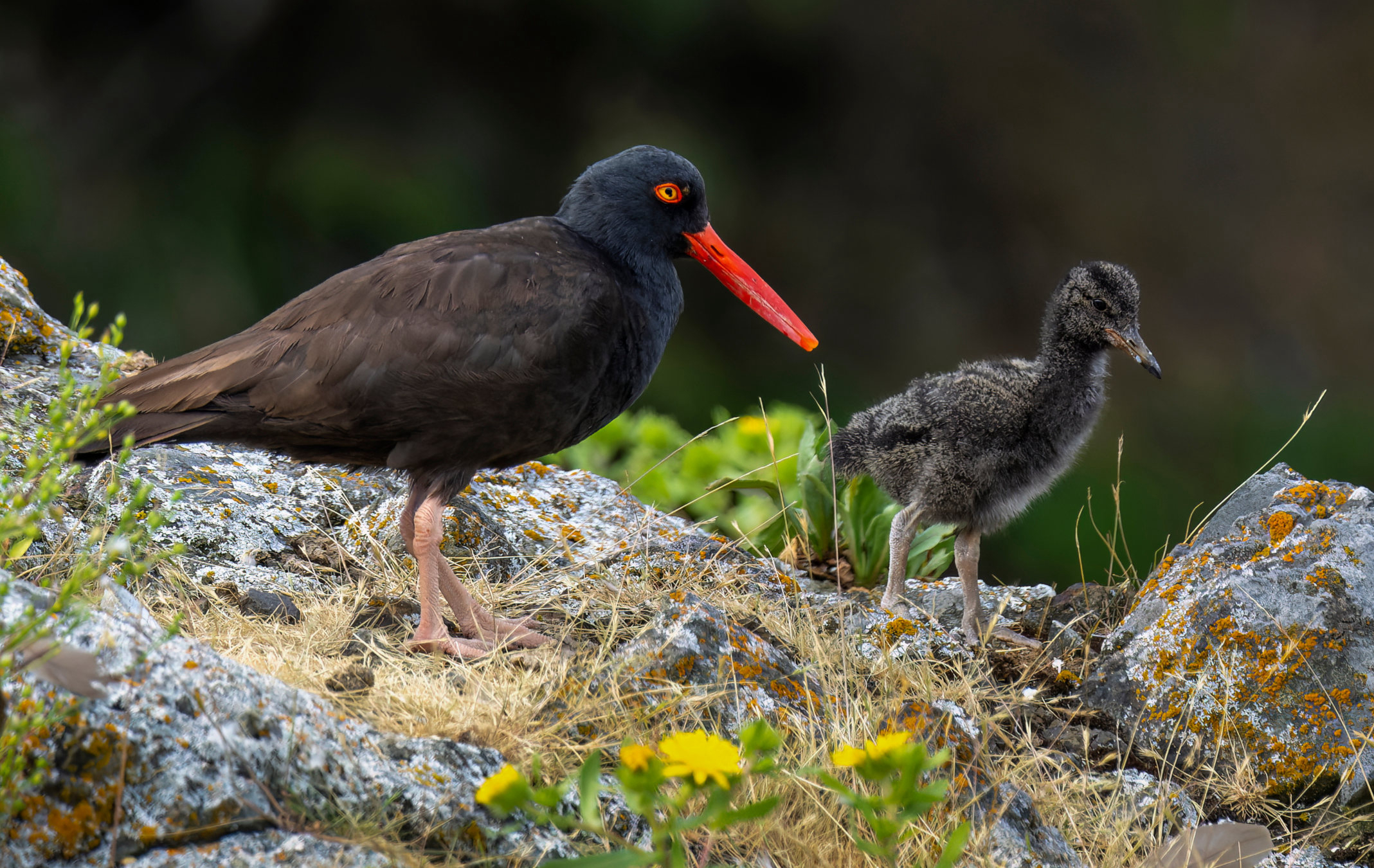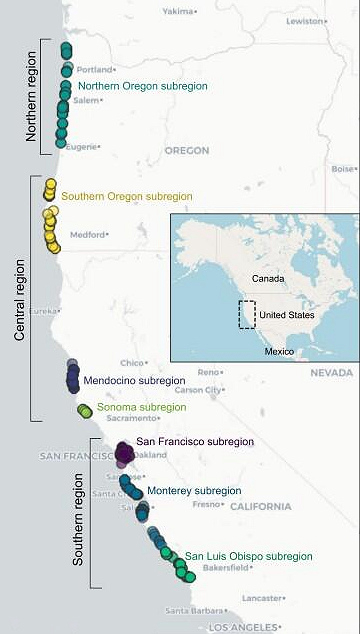
A study of nesting Black Oystercatchers has provided valuable information about the habitat use and nesting success of the species in California and Oregon (Black Oystercatcher photo of an adult and hatchling by Bonnie Block).

This map shows the primary nesting areas of Black Oystercatchers studied along the Pacific Coast in Oregon and California north of Santa Barbara.
|
Black Oystercatchers are found along a narrow stretch of shoreline on the Pacific Coast from southern Alaska to Baja, Mexico. These large shorebirds inhabit a very thin band of habitat – beaches and rocky shores between the high tide mark and the low tide mark, known as the intertidal zone. Along this intertidal zone, Black Oystercatchers can be seen foraging, roosting, and in season, nesting; but actually seeing a Black Oystercatcher is not an easy task with a total population of less than 17,000 birds in total. While the species isn’t officially listed as threatened, it is considered a species of conservation concern.
The species’ main nesting range is located north of Santa Barabara, California, while nesting is rarely reported to the south. Beginning in 2012, a collaboration of nearly 200 Audubon community scientists, agency staff, and science NGOs began assessing Black Oystercatcher populations and nesting productivity in California, spanning from San Luis Obispo County in the south through Mendocino County in the north. Key research partners include Oikonos Ecosystem Knowledge and Audubon chapters: Mendocino Coast, Golden Gate, Madrone, Marin, and Monterey chapters in California. Bird Alliance of Oregon launched a similar statewide monitoring program in 2015, working with the US Fish & Wildlife Service, US Geological Survey, coastal Audubon chapters, and other groups.
Using 10 years of robust information, a new research paper authored by Audubon California, the National Audubon Society, and Oikonos Ecosystem Knowledge was published in Marine Ornithology, which assessed productivity patterns and the variables affecting nesting success of Black Oystercatchers. The study divided nesting areas in California and Oregon into 3 regions based on biogeographic information. Study results showed a clear trend: Productivity was better in northern regions. Nesting pairs in southern regions averaged below the threshold needed to sustain a stable population, while most northern regions were productive at or above that threshold. Although the total nesting population studied is thought to be stable, young oystercatchers produced by northern nesting populations may help to keep less successful nesting populations in areas of California more stable, with some young birds relocating along coastlines to the south.
The researchers found that nesting success is closely linked to the location of each nest site. Nests positioned higher onshore, farther from the high tide line, or on offshore rocks were more successful, while nests positioned at lower locations were more susceptible to being washed out by waves during storms. This information also underlines the fact that as climate change leads to bigger, more frequent storms, nesting could become increasingly challenging for Black Oystercatchers.
Disturbance was also identified as a significant factor impacting nesting success. Human activity near nesting sites had a big negative effect, because onshore nesting sites positioned higher were more vulnerable to human disturbance, even though they were safer from wave action. This information highlights the broader issue that species not classified as threatened can still be at serious risk, especially when facing climate change too.
To protect Black Oystercatcher habitat and better understand trends in nesting success, long-term monitoring programs like this one are crucial. Reducing human disturbance at nesting sites and protecting offshore rocks and islands could be key strategies to the long-term success of Black Oystercatchers, while monitoring the effects of climate change over time.
The success of these conservation efforts has been made possible through funding from the Marisla Foundation, Resources Legacy Fund, US Bureau of Land Management, and private donations. Ongoing monitoring and community science initiatives will continue to play a critical role in better understanding and protecting Black Oystercatchers. For more information about this Black Oystercatcher study, you can refer to the original Audubon California article at Black Oystercatcher nest success from San Luis Obispo through Oregon | Audubon California